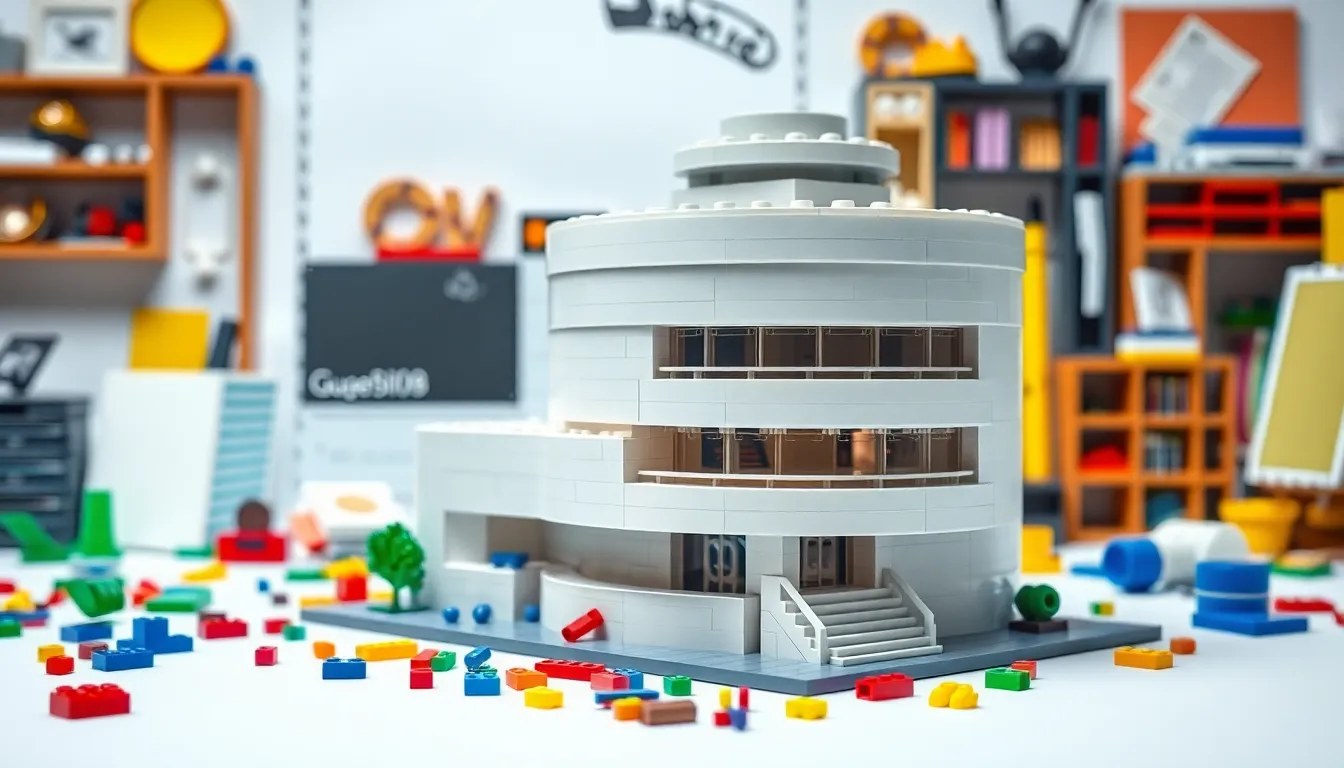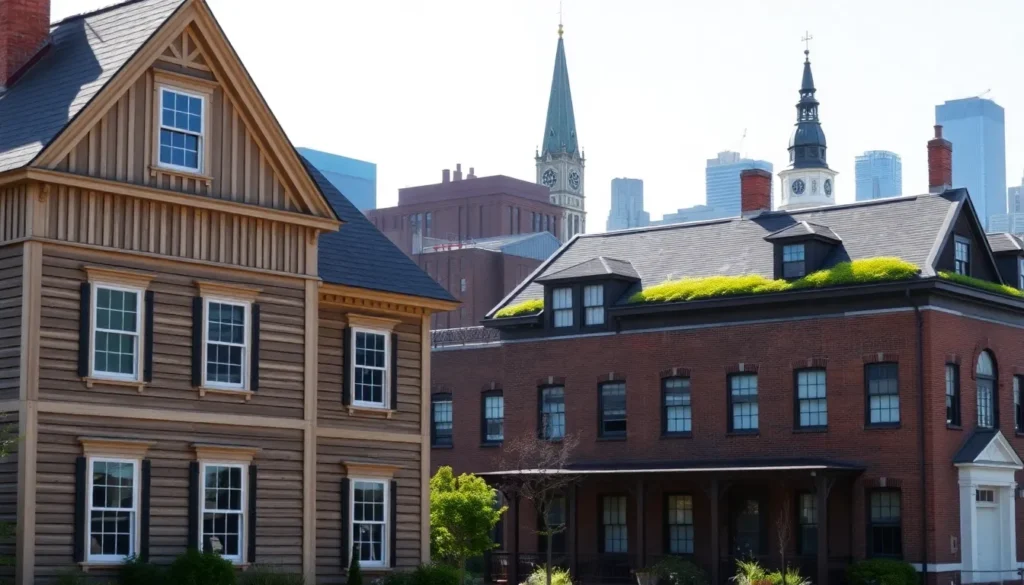Table of Contents
ToggleImagine transforming your living room into a miniature metropolis, all with the help of colorful plastic bricks. Lego architecture isn’t just child’s play; it’s a gateway to creativity, engineering, and a bit of nostalgia. Whether you’re a seasoned architect or someone who still struggles with assembling IKEA furniture, these intricate sets offer a chance to build iconic landmarks from around the globe, one brick at a time.
From the sleek lines of the Sydney Opera House to the majestic spires of Notre Dame, Lego architecture invites everyone to unleash their inner builder. It’s a playful blend of art and structure that makes even the most serious adults feel like kids again. So grab your bricks and let’s dive into the fascinating world where imagination meets construction—because who wouldn’t want to say they built the Eiffel Tower on a Tuesday night?
Overview of Lego Architecture
Lego architecture combines creativity with engineering, allowing builders to create impressive structures. The sets feature iconic landmarks, like the Eiffel Tower, the Empire State Building, and the Burj Khalifa. Various collection themes exist, spanning from famous buildings to unique structures inspired by architectural movements.
Each set includes detailed instructions, ensuring builders can recreate these masterpieces accurately. Designers place emphasis on color, shape, and size, allowing for artistic expression. Iconic structures become attainable through the use of standard Lego bricks that can be arranged in numerous ways.
Architectural enthusiasts enjoy the challenge of recreating complex designs. Experience levels vary, catering to beginners and advanced builders alike. The sets not only engage the mind but also improve fine motor skills and spatial awareness.
Many builders share their creations online, joining a global community that celebrates architectural accomplishments. Artistry and engineering blend together effortlessly, demonstrating that Lego is more than just a toy.
Lego architecture also encourages patience and attention to detail. Engaging in this activity fosters a deeper appreciation for real-world architecture and design principles. Events and exhibitions showcase these creative works, inspiring others to explore the art of building.
Having a Lego architecture kit offers countless hours of fun while stimulating creativity. Lifelong learners find joy in expanding their skills, and everyone can experience the satisfaction of constructing something remarkable.
History of Lego Architecture

Lego architecture traces back to the company’s original creation of interlocking bricks in 1949. Such innovation laid the foundation for countless building possibilities and set the stage for architectural exploration.
Origin of Lego Sets
Lego sets originated in Denmark, where Ole Kirk Christiansen founded the company in 1932. Initially, the focus was on wooden toys, but in 1947, Lego expanded to plastic bricks. The introduction of the modern brick design in 1958 marked a turning point, allowing for more versatile and stable constructions. Iconic sets such as the Lego Town series emerged in the 1970s, providing builders with structured themes and environments. This early focus on creativity spurred interest in more specialized themes, driving demand for architecture-related sets.
Evolution Over the Years
Over the decades, Lego architecture evolved significantly. The introduction of the Architecture series in 2008 gave builders opportunities to replicate famous landmarks. Sets representing the Guggenheim Museum and the Sydney Opera House showcased intricate designs while emphasizing real-world architectural principles. Expanding collections featured diverse styles, from classical to modern structures, catering to various interests. Collaborations with renowned architects further enriched the line, blending artistic vision with accessible creativity. Today, builders of all ages enjoy bringing iconic designs to life, fostering community engagement and inspiring future architects.
Popular Lego Architecture Sets
Lego architecture sets bring iconic structures to life in miniature form. Various options cater to collectors and enthusiasts alike.
Landmark Models
Landmark models like the Sydney Opera House and the Eiffel Tower stand out among Lego’s offerings. These sets highlight intricate details, allowing builders to recreate the unique features of each structure. The Burj Khalifa, known for its height and design, also offers a dynamic building experience. In total, the Architecture series includes over 30 landmark sets that reflect real-world architectural styles. Collectors seek these models for their beauty and fidelity to the originals, making them prized additions to any collection.
Unique Designs
Unique designs characterize Lego architecture sets, emphasizing creativity and innovation. Structures such as Fallingwater and the Taj Mahal showcase diverse architectural principles in visually stunning ways. The sets target different skill levels, ensuring accessibility for both novices and seasoned builders. Each set presents engaging challenges that stimulate creativity. Additionally, specialized pieces recreate distinct architectural elements, enriching the building experience. Fostering artistic expression, these designs inspire builders to appreciate the art of architecture.
Benefits of Engaging with Lego Architecture
Engaging with Lego architecture offers a variety of benefits, from enhancing creativity to providing educational opportunities.
Creativity and Problem Solving
Building with Lego architecture nurtures creative thinking and problem-solving skills. Each set presents unique challenges that require builders to devise solutions. Different perspectives emerge as individuals experiment with designs and construction techniques. Exploring new ideas encourages innovative approaches, leading to original creations. When faced with complex structures, builders develop critical thinking skills to overcome obstacles. This blend of creativity and logic results in satisfying projects that instill confidence and accomplishment.
Educational Value
Lego architecture serves as a powerful educational tool. It promotes understanding of architectural concepts and engineering principles. Students gain insights into symmetry, balance, and spatial relationships while assembling models. Engaging with various architectural styles expands cultural knowledge and appreciation. Each building reflects real-world design elements, enhancing lessons in art and history. Additionally, working with instructions boosts reading comprehension and following multi-step processes. Builders of all ages experience learning through hands-on activities, fostering a love for architecture that carries into future studies.
Community and Culture
Engagement with Lego architecture cultivates a vibrant community where builders connect, share, and inspire one another.
Online Forums and Social Media
Numerous online forums and social media platforms buzz with discussions centered around Lego architecture. Builders showcase their creations, seeking feedback and appreciation from fellow enthusiasts. Popular platforms like Instagram and Reddit have dedicated groups that celebrate architectural designs built with Lego. The ease of sharing photos and videos allows for instant engagement, fostering a sense of belonging among creators. Many builders exchange tips and techniques, enhancing each other’s skills while exploring new design possibilities. Instagram hashtags like #LEGOArchitecture and #LEGOBuilder have become popular, creating a collaborative atmosphere that inspires creativity and innovation.
Exhibitions and Competitions
Exhibitions and competitions highlight the creative talents within the Lego architecture community. Annual events, such as Brickworld and the LEGO Fan Expo, attract builders from around the globe who display impressive works of art. Each exhibition showcases diverse interpretations of famous structures, encouraging creative expression and unique perspectives. Competitions, often hosted by local Lego clubs, provide opportunities for builders to challenge themselves and receive recognition for their efforts. Winners typically gain accolades and often have their work featured online or in publications. These events not only promote craftsmanship but also strengthen community ties as builders share their passion for architecture through Lego.
Lego architecture stands as a testament to creativity and engineering. It invites individuals of all ages to explore their artistic side while building iconic landmarks. This engaging hobby not only enhances fine motor skills but also fosters a deeper appreciation for architectural principles.
The vibrant community surrounding Lego architecture further enriches the experience. Builders share their creations and inspire one another, creating a global network of enthusiasts. As they connect through social media and events, their passion for architecture continues to grow.
Ultimately, Lego architecture is more than just a pastime; it’s a journey into the world of design and creativity. Whether for fun or education, it offers endless opportunities for exploration and expression.


